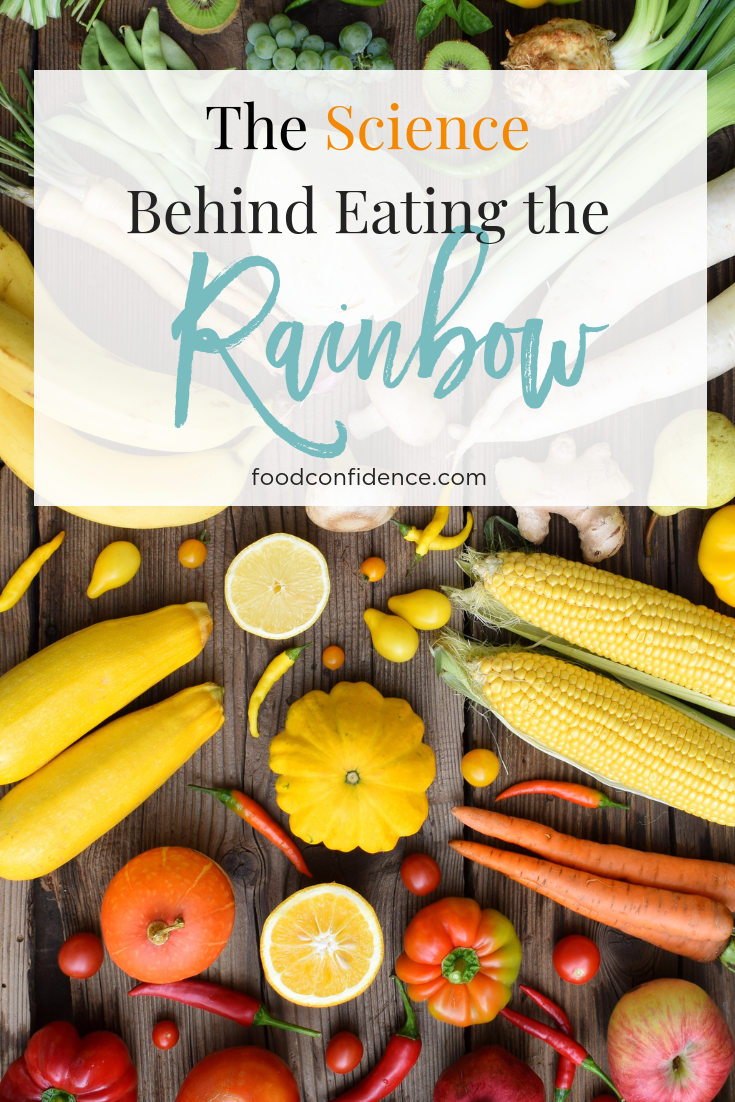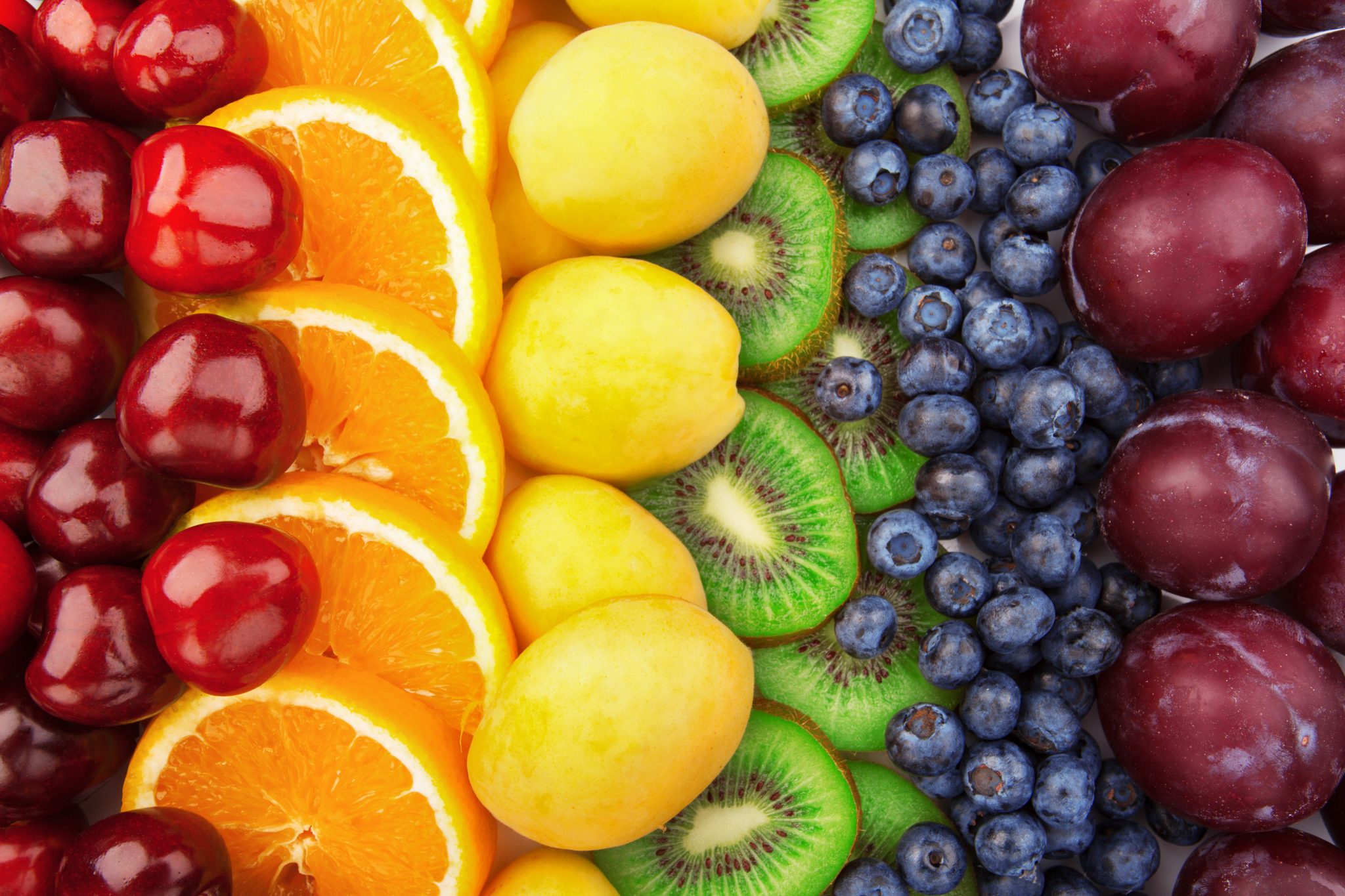“Eat the rainbow.” Chances are, you’ve been told this countless times growing up. But what does “eat the rainbow” really mean? Why is it so important to incorporate different colorful fruits and veggies in your diet?

It’s easy to settle on a handful of fresh fruits and vegetables that you and your family enjoy, but diversity is just as important as quantity when it comes to vegetable intake, gut health, and overall wellness.
I’ve always been a heavy plant eater, but even I can get stuck in a veggie rut or just focus on my favorites all the time. But after listening to a nutrition researcher at a conference discuss the importance of diversity for gut health, I now strive to get in at least 30 different varieties of plant foods each week! I know, at first it sounds like crazy talk, but trust me, after trying it, it’s really not as hard as you think.
What makes food so colorful?
The beautiful colors you see in fruits and vegetables is from antioxidant phytonutrients called carotenoids and flavonoids.
- Carotenoids have been shown to decrease the risk of disease, particularly certain cancers and eye diseases. The most-studied carotenoids are beta-carotene, lycopene, lutein, and zeaxanthin.
- Anthocyanins are flavonoids responsible for the red-purple-blue colors found in berries, currants, grapes, leafy vegetables, grains, and root veggies.
I stumbled upon some research recently suggesting that eating specific fruit & veg colors actually correlates to less disease risk in different areas of the body. For example, in this study, eating white fruits & vegetables was most associated with reduced stroke incidence. Each 25-g per day increase in white fruit and vegetables was associated with a 9% lower risk of stroke.
In this study, eating green and white fruits & veg was inversely related to abdominal fat gain and cardiovascular risk factors in men. While in women, a higher intake of red and purple produce was associated with lower weight and abdominal fat gain, fasting serum glucose, and total cholesterol. In this study, researchers also looked at which fruit and vegetable color groups protect against coronary heart disease. They found that for each 25 gram increase in deep orange fruit and vegetables, there was a 26% lower association with heart disease. Eating carrots was actually associated with a 32% lower risk of coronary heart disease!
By prioritizing a wide range of colors when choosing your produce each week you can be sure that you’re getting a variety of nutrients you need to optimize your health and feel your best.
Let’s eat the rainbow, shall we?
We know that the phytonutrients in plants are associated with powerful health effects. We also know that phytonutrients are very functional – especially when it comes to helping your body’s natural detoxification systems and boosting your immune system.
Fresh fruits & veggies, whole grains, herbs & spices, legumes, nuts & seeds — they are all jam-packed with phytonutrients…and they come a whole host of different colors. The colors of the rainbow.
To optimize your health, it’s super important to eat fresh foods of various colors every day. If you shoot for 1-2 servings of different color veg every day (the darker the better), by the end of the week you may just be closer to 30 different types then you ever thought possible!
Let’s look at how EASY it is to get there…
Red
Foods that are red help reduce cancer risk, boost your immune system, and enhance brain and heart health. This is because they contain compounds like anthocyanidins and lycopene.
Try incorporating foods like apples, beets, red bell peppers, cranberries, cherries, grapes, plums, pomegranates, raspberries, strawberries, and tomatoes. I highly recommend spicing up your next pasta dish with a bunch of chopped veggies and a tomato-packed marinara sauce. An easy summer dish to try are these zoodles with fresh cherry tomatoes and bell peppers.
Orange
Foods that are orange help boost your immune system and optimize eye and skin health. This is because they contain compounds like beta-carotene and curcuminoids.
Try incorporating foods like apricots, orange bell peppers, carrots, mangos, oranges, pumpkin, sweet potato, and turmeric. Personally, I like to keep dried apricots in my bag for a quick snack when I’m on the go. I also love this refreshing chia fresca with pineapple and turmeric.
Yellow
Foods that are yellow are anti-inflammatory and promote eye, skin, brain and heart health. This is because they contain compounds like lutein and zeaxanthin.
Try incorporating foods like golden apples, pears, bananas, yellow bell peppers, lemons, pineapple, and summer squash. Personally, I love chopping up bell peppers to dip into hummus or guacamole when I want a quick snack. Whipping up this lemony vinaigrette for salads is super easy to do, too.
Green
Green foods are anti-inflammatory, support your liver, and are vital for brain and heart health. This is because they contain compounds like chlorophyll and isoflavones.
Try incorporating foods like asparagus, avocados, green bell peppers, broccoli, Brussels sprouts, cucumbers, edamame, leafy greens, limes, and zucchini. This is my favorite color to eat because salad is a way of life for me and I’m able to incorporate so many different green foods into one bowl. Here’s how to create the perfect salad bowl.
A fruit-packed smoothie that’s full of greens is an easy go-to, too. Pro tip: Add a handful of spinach and a 1/4 of an avocado to your next fruit smoothie. I promise you won’t taste the spinach and the avocado will add a lovely creaminess.
Blue & Purple
Foods that are blue and purple are anti-inflammatory, anti-cancer, and are good for the brain! This is because they contain compounds like anthocyanidins and resveratrol.
Try incorporating foods like blueberries, blackberries, cabbage, purple cauliflower, eggplant, grapes, plums, and prunes. I always have a bag of Wild Blueberries in the freezer and I’ve made everything from crumb cake to energy balls using them. You can also freeze grapes – I know, it sounds a little weird, but trust me – it’s a delicious and refreshing snack on a warm summer day!
White & Tan
When it comes to phytonutrients, the rule of thumb is the darker the plant food = the more nutrient dense. But white and tan plant foods are the exception! These plants are pretty amazing as anti-inflammatories, plus they support a healthy liver, and optimize hormone health. This is because they contain compounds like allicin and tannins.
Try incorporating foods like apples, cauliflower, coconut, dates, garlic, ginger, chickpeas, peanuts, mushrooms, onions, flax seeds, hemp seeds, sunflower seeds, tahini, and whole grains. Sneaking a spoonful of tahini into your favorite creamy soup recipe is a great way to add a great depth of flavor, an irresistible texture, and a ton of nutrients to your meal.

“Eat the Rainbow” with these 5 Tips & Tricks
Now that you know why it’s important to “eat the rainbow” here are a few more tips and tricks for adding phytonutrients in your diet – and getting close to eating 30 different plant varieties per week!
- When you’re writing your grocery list, make it a point to add 1-2 new plant foods each week.
- Keep a variety of colorful produce (berries, leafy greens, etc.) in your freezer for easy smoothie making.
- Take the time to chop some veggies in the beginning of the week or have a few bags of frozen veg on hand. This makes it easy to grab a handful of chopped veggies for a quick stir fry when you’re in a pinch.
- Keep fruit on the counter in your kitchen or on your desk at work for easy access.
- Nothing is worse than buying produce and having it go bad before you get a chance to use it! Be sure to use fruits and veggies that go bad easily at the beginning of the week and save the others for the end of the week.